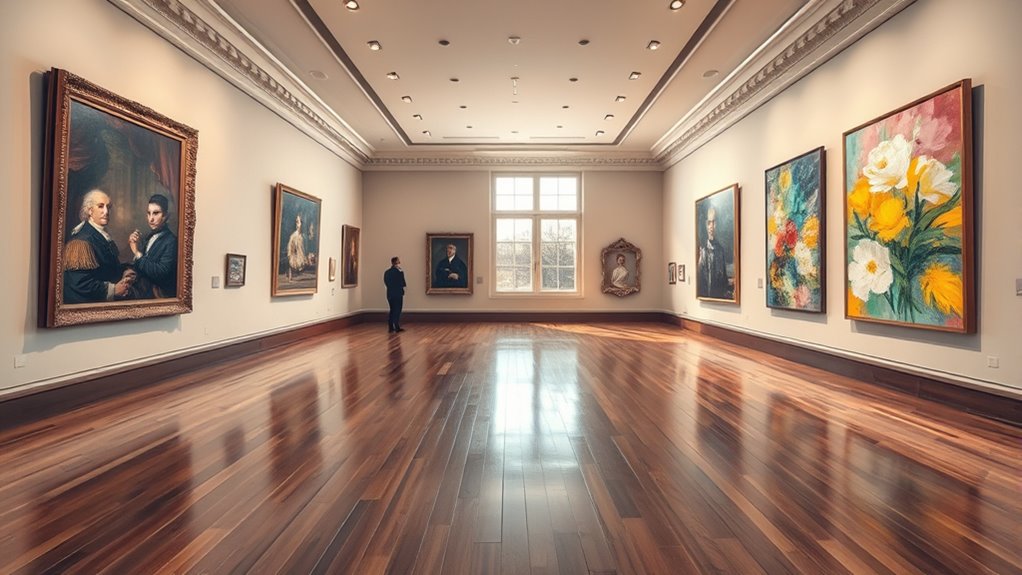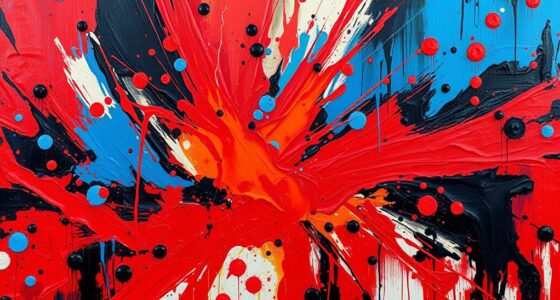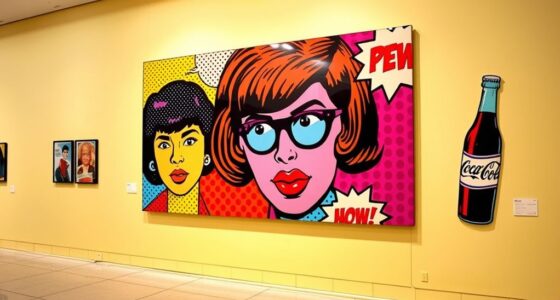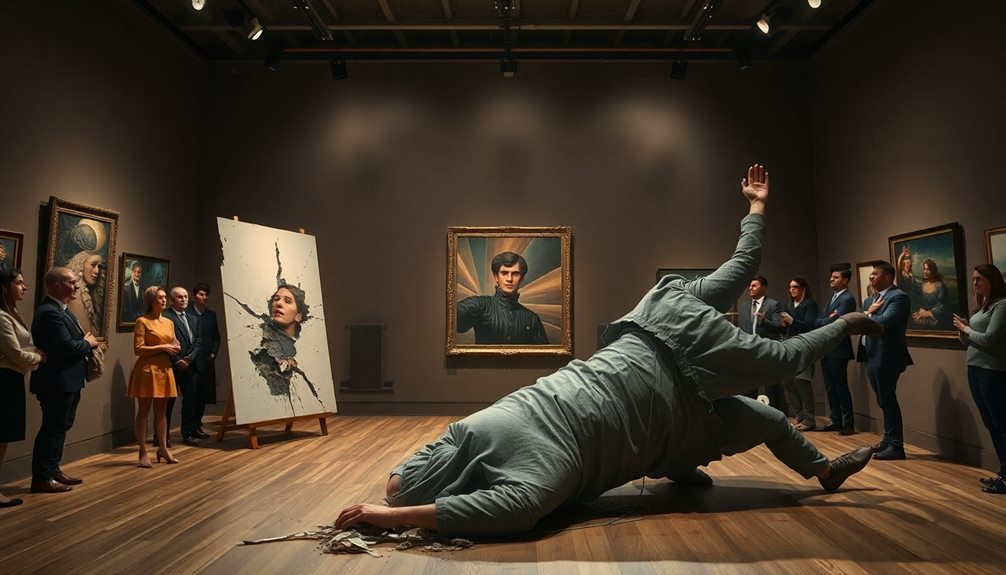You see how art evolved from academic masters focusing on realistic detail and precise techniques like chiaroscuro and perspective, to Impressionists who embraced spontaneity, light, and fleeting moments. This shift reflects a move away from strict realism toward personal expression, experimentation, and capturing sensory experiences. Today’s artists build on this legacy, pushing boundaries with new materials and ideas. If you keep exploring, you’ll discover how these groundbreaking changes continue to shape the art world.
Key Takeaways
- The academic focus on precise realism and classical techniques shifted towards experimental, impressionistic styles emphasizing light, color, and personal perception.
- Philosophical changes moved art from idealized forms to embracing imperfection, spontaneity, and everyday life subjects.
- Impressionism challenged traditional realism by prioritizing fleeting moments and atmospheric effects over meticulous craftsmanship.
- Technological advancements facilitated new materials and digital experimentation, expanding artistic boundaries beyond classical methods.
- The evolution reflects a progression from disciplined realism to expressive, avant-garde practices, redefining artistic expression over time.

Have you ever wondered how traditional art schools evolved into hubs of experimental creativity? It’s a fascinating journey that reflects the shifts in techniques development and artistic philosophies over time. In the days of classical academies, artists focused on mastering realistic representation through precise techniques like chiaroscuro, sfumato, and linear perspective. These methods aimed to create depth, volume, and lifelike accuracy, emphasizing idealized beauty and meticulous craftsmanship. The curriculum centered on copying classical sculptures and Renaissance masters, fostering a shared understanding of the human form and the natural world. This approach promoted discipline and technical mastery, shaping the standards of academic art for centuries.
But as you explore the progression to more experimental forms, you notice how artistic philosophies began to shift away from strict realism. The rise of Impressionism marked a key turning point, challenging the idea that art should merely imitate nature. Instead, Impressionists focused on capturing fleeting moments, the play of light, and the atmosphere of a scene. Techniques evolved to emphasize loose brushwork, vibrant colors, and a focus on perception rather than precise detail. Artists like Monet and Renoir prioritized expressing their personal impressions and emotional responses, breaking free from the rigid constraints of academic tradition. This shift was not just a stylistic change but a philosophical one—art was now about subjective experience and individual expression.
As you trace this evolution, you see how the artistic philosophies underpinning the movement shifted from a focus on ideal forms to embracing imperfection and spontaneity. Impressionists rejected the notion of art as a vehicle for moral or historical lessons, instead celebrating everyday life and the sensory experience. Their approach encouraged experimentation with new techniques, such as plein air painting and rapid brushwork, which allowed them to respond directly to their environment. This willingness to challenge established standards opened the door for later avant-garde movements, which further pushed boundaries by exploring abstract forms, non-traditional materials, and conceptual ideas. Additionally, the development of color accuracy in projectors and paints has played a role in emphasizing visual fidelity and emotional impact in modern art and media. Furthermore, the integration of new technologies has enabled artists to experiment with digital mediums, further expanding the scope of artistic expression. Interestingly, recent innovations in techniques development continue to influence contemporary art, bridging traditional methods with modern innovations.
In essence, the progression from academic realism to Impressionism exemplifies how techniques development and artistic philosophies interact to reshape the boundaries of artistic expression. You see the progression from disciplined craftsmanship to personal exploration, a journey fueled by a desire to represent not just what’s seen, but what’s felt. This evolution continues today, inspiring contemporary artists to experiment boldly and redefine what art can be, just as the Impressionists did over a century ago.
Frequently Asked Questions
How Did Social Changes Influence Artistic Movements During This Period?
Social changes, like shifting social class structures and political upheaval, deeply influenced artistic movements. You see artists respond by depicting everyday life and ordinary people, breaking away from classical ideals. These movements reflect a desire to challenge traditional norms, making art more accessible and relevant. As society evolves, artists adapt their work, capturing the turbulence and new perspectives born from these social and political shifts.
What Role Did Technology Play in Shaping Impressionist Techniques?
Imagine technology quietly transforming art—digital brushwork and optical color become your tools. You leverage these innovations to capture fleeting moments with vibrant, broken strokes, creating a fresh visual language. As you experiment, you realize that technological advances release new possibilities for impressionist techniques, allowing you to depict light and atmosphere more vividly than ever before. This subtle shift in tools sparks a revolution, shaping your art in ways you never imagined.
Were There Notable Female Artists Within These Movements?
You’ll find that female pioneers, despite facing gender barriers, made significant contributions to Realism and Impressionism. Artists like Berthe Morisot and Mary Cassatt broke through societal expectations, showcasing new perspectives and techniques. Their work challenged traditional gender roles, inspiring future generations. Though often overlooked, these women’s innovative approaches helped shape the movements and prove that art’s evolution depends on diverse voices overcoming obstacles.
How Did Critics Initially Respond to the Shift From Realism to Impressionism?
You’ll find that critics initially responded to the shift from realism to impressionism with critic backlash, often dismissing the new style as unfinished or superficial. They struggled to accept artistic innovation that broke traditional rules, feeling it undermined academic standards. Despite their resistance, artists pushed forward, gradually gaining recognition. Over time, critics began to see impressionism’s value, leading to a broader acceptance of this revolutionary approach.
What Are the Lasting Impacts of These Art Movements on Contemporary Art?
You see that Realism and Impressionism profoundly influence contemporary art through their focus on color theory and artistic innovation. These movements encourage you to experiment with color, light, and everyday scenes, fostering a more personal and expressive style. Their emphasis on capturing fleeting moments and individual perception inspires modern artists to break traditional boundaries, pushing creative boundaries and expanding the possibilities of visual storytelling today.
Conclusion
As you journey through the shift from Academy to Avant-Garde, you see art bloom like a daring sunrise—bold, unpredictable, alive. The brushstrokes of realism ground you in truth, while impressionism’s fleeting light invites you to chase fleeting moments. Embrace this evolution, where tradition and innovation dance together in an eternal waltz. Just as dawn transforms night into day, your understanding deepens, revealing that art’s true power lies in its endless rebirth.









